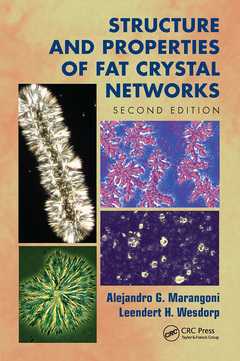Description
Structure and Properties of Fat Crystal Networks (2nd Ed.)
Authors: Marangoni Alejandro G., Wesdorp Leendert H.
Language: English
Subjects for Structure and Properties of Fat Crystal Networks:
Keywords
Fat Crystal Network; Cocoa Butter; cocoa; Fractal Dimension; butter; SFC; shear; Fat Crystallization; strain; Fat Crystal; rate; Avrami Exponent; free; Milk Fat; energy; Fat Samples; fractal; Storage Modulus; dimension; Viscoelastic Material; elastic; AMF; Microstructural Elements; Sample Preparation; Sporadic Nucleation; Lifshitz Theory; Phase Angle; Hookean Solid; Nucleation Rate; Induction Times; Shear Strain Rate; Polarized Light Micrographs; Peltier Plate; Crystal Memory; Weak Link Theory
Publication date: 06-2024
· 15.6x23.4 cm · Paperback
220.72 €
In Print (Delivery period: 15 days).
Add to cartPublication date: 09-2012
500 p. · 15.6x23.4 cm · Hardback
Description
/li>Contents
/li>Readership
/li>Biography
/li>
Lipid science and technology has grown exponentially since the turn of the millennium. The replacement of unhealthy fats in the foods we eat, and of petroleum-based ingredients in the cosmetics we use, is a top priority for consumers, government, and industry alike. Particularly for the food industry, removing trans fats and reducing saturated fat in foods has produced a major challenge: How do we create structure with a minimum amount of structuring material?
A comprehensive omnibus, Structure and Properties of Fat Crystal Networks, Second Edition clarifies the complex relationship between triglyceride composition of vegetable oils and fats, the physicochemical properties of triglycerides in simple and complex model systems, their crystallization, and melting behavior. Furthermore, it dives into the implications of these materials on the functional properties in food systems.
Replacing ingredients, optimizing functionality, and improving health necessitate the ability to relate the structural organization present in a material to macroscopic properties. Revisiting concepts and approaches used in the study of fat crystal networks, the second edition includes new developments, particularly intermolecular interactions, and thoroughly updated analytical methods. Succinct, clear, and complete, this book is designed to help students and early-career researchers make the study of fats a more focused, less frustrating, and less expensive endeavor.
Review of Crystallography. Nucleation, Crystal Growth, and Structural Implications. Intermolecular Forces in Triacylglycerol Particles and Oils. Rheology of Solids. Viscoelastic Behavior. Dynamic Methods. Microstructure and Nanostructure. Yield Stress and Elastic Modulus of a Fat Crystal Network. Liquid–Multiple Solid Phase Equilibria in Fats. Experimental Methodology.
Alejandro G. Marangoni, Professor and Canada Research Chair, Food and Soft Materials Science, University of Guelph, ON, Canada. His work concentrates on the physical properties of foods, particularly fat crystallization and structure.




